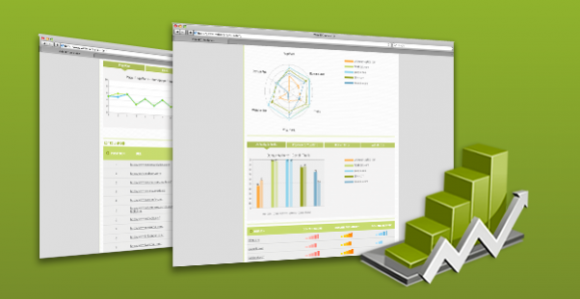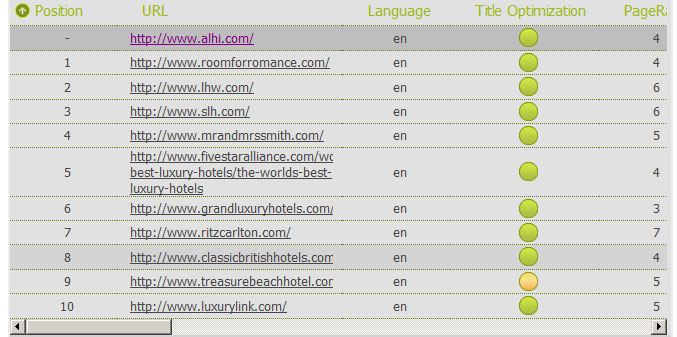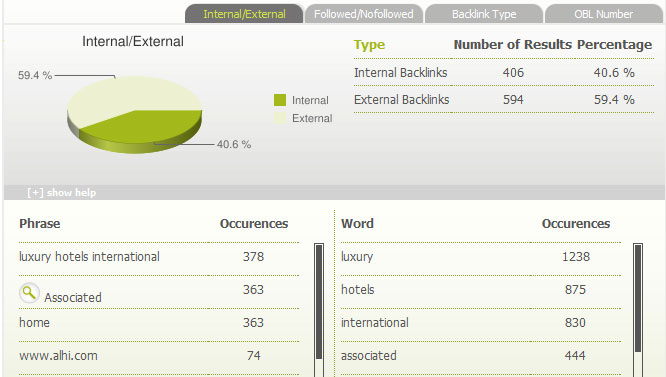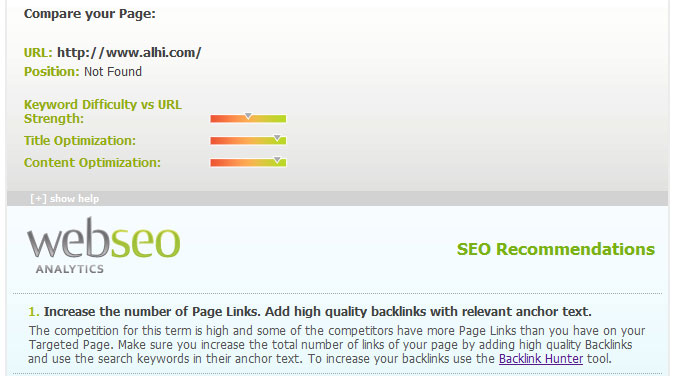Analyzing Search Engine Results: The fine art of SEO

One of the most essential parts of the SEO campaign is selecting the right keywords right. In order to do so you must have a good understanding of your website’s strength, of the competition on Search Engine Results and of the way that people search. In this blog post we will focus on how to analyze the competition on Search Engine results and on how to find out what it takes to achieve high rankings based on the SEO campaigns of your competitors.
Which are the right Keywords?
The right keywords are the ones that have the following characteristics:
- They are relevant to your website’s content.
- They will drive large amounts of targeted traffic to your website (visitors that are likely to convert into sales).
- The competition of the particular keyword on the Search Engine Result Pages (SERP) is manageable. This means that your website should be strong enough to compete and to achieve high results.
The first 2 characteristics have been extensively covered on the articles “Keyword Research: The core of your SEO Strategy” and “How to create an effective keyword list”, thus in this post we will focus on how to evaluate the competition on SERPs.
Important signals that affect Search Engine Results
In order to understand whether it is possible to rank for a particular term we should take into account several factors. Google suggests that they use more than 200 signals and additionally lots of SEO experts suggest that the recipe might vary depending on the type of search. So in order to evaluate the competition on Search Engine Results we should take into account at least the following factors:
- Domain & Page Strength: The number of incoming links, the quality of the backlinks, the PageRank values, etc.
- Keyword Usage/Relevancy: The theme of the page, the usage of the keywords in that page, the optimized terms (the KeywordRank values) etc.
- Domain name & URL: The keywords in the domain name and in the URL.
- Social Media Reputation: The popularity of the website in social media (the WuzzRank), the buzz on popular networks etc.
- SERP Context data: The language of the pages that appear on the results, the TLD of the domains, the Geo location of the websites, whether the results are related to a particular geographical area and all the data that we can get from the context of the SERPs.
- Link Data: The anchor texts of the incoming links, the relevancy of the linking pages etc.
We should note here that these are only some of the signals that are taken into account and that none of them individually can heavily affect the results. Also note that the analysis of the SERPs requires experience and that the more experienced you are, the more easily you will distinguish patterns (it’s the fine art of SEO).
Using a real life example
In this blog post we will use a real life example. We will select a term and a website, we will try to evaluate the competition and we will see what we should do in order to achieve higher rankings in Search Engines.
We chose to analyze the results on Google.com for the term “luxury hotel”. We also picked out randomly one of the results that are currently appearing on the 7th page of Google. The domain that we will try to optimize is the www.alhi.com.
In order to evaluate the competition and find out whether it is possible and what we should do to rank for the selected keyword we follow the next steps:
Step 1: Analyze the Competition
The first thing we need to do is to see which are our competitors, what is their SEO campaign and if there are sites that we can outrank by optimizing our website appropriately. Thus the first step is to check the results for the particular keyword. This we can be done either manually or by using tools. In this blog post we are using the SEO Tools that are provided in Web SEO Analytics toolbox to save time and to make use of the useful analytics & metrics that they provide.
Let’s start by checking the competition on search engine results with the SERP Analysis tool. We use as input both the selected term and the URL of the site.
After checking the results it is clear that the website alhi.com has relatively low number of incoming links and PageRank. Luckily there are also some other results that have the same or even less domain strength than our website. We can spot this easily by checking the following graphs:

The next thing that we should see is the language of the results and the title optimization. We can easily spot that all the results are written in English and that the result in position 9 is not optimized for the term “luxury hotel”. This fact along with the low number of incoming links & domain strength of the competitor makes it easier for us to outrank it.
Other useful statistics that can be examined in this table are: The WuzzRank (Social Media Reputation) of each page and domain, the Domain Authority, the Domain Age and more. Note that some of the statistics that appear in the table are not directly related to the SEO performance but they are good indicators of the strength of the competitor. Such metrics are: the Domain Traffic stats, the indexing Stats in Google, Bing and Yahoo, the indexing status on DMOZ, the average Speed and more.
Other useful statistics that we can get from the analysis are the ones that are related with the Average and Median values of various metrics of the SERPs. The below metrics can give us an idea of how intense the competition is for the particular keyword. Additionally the appearance of Images and News in the Search Results indicate that we might be able to achieve easier better rankings by optimizing our website for the Universal Search Result entries.
The next thing we should look is the statistics that come from the SERP results. These statistics provide information about the URL, the TLDs, the DMOZ Stats, the Domain Keywords usage and lots of other useful details. Let’s focus on the Domain Keywords stats:
As we see above 4 out of 10 results have at least one of the words “luxury” and “hotel” in their domain names. This makes it more difficult for us to achieve higher rankings because the domain name of alhi.com does not include any of those terms.
Finally after carefully evaluating all the metrics we should see what is the Strength of our Website for this keyword comparing to the competitors.
The above list orders the URLs that were found in Search Engine Results by their Strength. The 1st URL is the strongest for the particular query and the last one is the weakest. Several parameters are taken into account such as link & domain authority, keywords in the domain, PageRank values, links quality and quantity and more. Note that this list does not take into account the title relevance or text optimization. It focuses primarily on factors that are more difficult to optimize such as Links, Authority, Domain keywords and off page optimization. By using this list you can identify which are the competitors that are easier to be out-ranked from the results and optimize your URL in order to achieve better rankings.
As we see our page ranks on position 10 indicating that our strength is quite low. Still it clearly shows us that the domain on position 11 has lower strength than ours and that we could out rank it. Note that this is the same result that we marked before as potentially easier to outrank due to the non-optimized title and low number of links.
Step 2: Analyzing the SEO campaigns of the Weak Links in the Chain
Until now we have identified how intense the competition is and which domains are more likely to be outranked. In this step we have to analyze the competitors, their SEO campaigns, their link building campaigns and then we will create a plan on how we can optimize our website.
The first thing that we should do is to check their Websites in order to find for which terms they are optimizing their pages, their keyword usage, their link structure and the backlinks of their domains.
We will not get into details for this step since it is beyond the scope of this article. Nevertheless here is a list of the things that you should look for:
- Are those sites optimized for the particular terms?
- Do the terms appear in the title and even better, are they the first words in it?
- Is the Title, H1-6, Metatags etc relevant to the context of the page?
- What is their link structure?
- What type of links do they get and what anchor text are they using?
To check the first 3 factors you can use either the Web SEO Analysis or the Keyword Analyzer tools. Both of them provide all the information that you need to see how optimized their landing pages are. The image below provides only a small part of the statistics:
In order to evaluate their link structure and how the link juice flows from the landing pages you can use the Link Structure tool. Here is a small part of the report:
Finally in order to evaluate their Link Building campaign you can use the Backlink Analysis tool or the Majestic SEO tools. Both of them provide detailed analysis about the number, the anchor texts and the quality of the backlinks. Note that if your competitors receive lots of high quality links with the query keywords in the anchor text, it will be more difficult for you to achieve better rankings.
Finally we should run exactly the same tests on our website and landing page and compare our results with the ones of our competitors. In this way we prepare for the next step which is to optimize our website in order to achieve high rankings.
Step 3: Optimizing our Website
After analyzing the competition on SERP and evaluating the SEO campaigns of our main competitors, we should create a plan on how to optimize our website. Armed with the knowledge that we acquired by the previous steps, we should be able to see which parts of our website should be improved in order to achieve the rankings.
At the end of the SERP analysis we can see 3 ranks and a list of actions that we should do in order to optimize our website.
The Keyword Difficulty vs URL strength shows us how difficult it is for us to rank for this term. If the arrow is on the red area it means that it is rather difficult to rank for this term and that we should search for another term that is less competitive. The title and content optimization ranks show us whether our landing page is optimized for those terms. This should also be visible from the analysis that we did in step 2 on our website.
Finally at the end of the report you will find the section that is called SEO Recommendations. This section is based on the analysis of the results and of your Website and it proposes actions that you should do to improve your Link Building campaign, the Link Structure of your website, your Keyword Optimization, your Social Media campaigns and other SEO related actions.
It is not mandatory to use SERP Analysis tool in order to evaluate the competition. Nevertheless this tool provides all the useful metrics that you need, it visualizes the results, it evaluates the competition by using clever algorithms and statistical analysis and also it provides you with a concrete plan on how you should optimize your website.
Analyzing the Search Engine Results is the fine art of SEO. The more you do it the better you become. Don’t forget that you should not only focus on the metrics and statistics but also use your own experience and be creative!
Don’t forget! If you enjoyed this article make sure you share it with your friends. 🙂

 14 Comments
14 Comments












